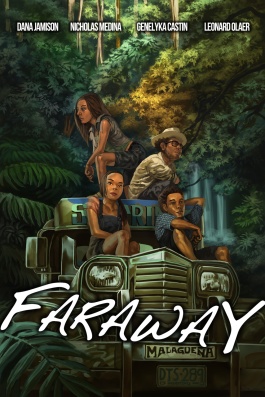
A few years ago, I had the opportunity to work with a budding director on a shoot in Fillmore, CA. Amidst the beautiful orange trees and fruit groves, I’ve subconsciously called the town “Film-more” ever since. Continuing to weave beautiful locations into his scripts, filmmaker Randal Kamradt takes independent filmmaking to a new level in his latest film Faraway. Gone are the days where new filmmakers are limited to shoots in their basements, backyards, or friend-of-a-friend’s coffee shop. I used to imagine directors at the pinnacle of their careers, finally capable of shooting internationally, letting the story guide production rather than production limitations confining the story. Yet Kamradt boldly and courageously proves that emerging filmmakers can work internationally, creating unique stories that are equally picaresque as they are picturesque.
“Many indie filmmakers make their movies hoping that it will be a gateway to making the bigger movies they really want to make. I figure it’s so hard to make anything at all that I should only make the movies I’m dying to make.” ~ Randal Kamradt
Set in the Philippines, Faraway is full of action and adventure, with elements of romance, fantasy and horror creeping in as the plot twists and turns. Kamradt successfully blends creative storytelling with unique and rare locations. Trekking into the jungle at night with equipment and crew, not speaking the local language, and shooting multiple action sequences with limited finances are not a challenges that every director can handle. Kamradt tackled the task, and in doing so, created a breakthrough film that opens the door to new filmmaking possibilities. When speaking of the project, he pragmatically states, “I figured it was just barely on the edge of being feasible. Which is really were we should always be as artists.” I’ll be eagerly awaiting his next film to see what new landscapes he explores and what creative twists and turns develop along the way. With Faraway in the spotlight, here’s what I asked the film’s director:

Q: What inspired a film set in the Philippines?
Kamradt: The story really was inspired by the location. Once I knew that this film would be done in Philippines I realized it was a chance to fulfill a long standing ambition of mine to make an adventure film. I realized that to have a John Ford style adventure film in today’s world, it would have to be rooted in myth and legend. The heroes needed to perform some sort of important function like save the world or change the world, and for that I needed a world where some form of magic exists. That’s the basic starting point, anyway.
The idea of going to the Philippines to shoot it came from my mother, who comes from Philippines. I had only been there twice for very short visits, but when she suggested it I realized there was a lot of potential. Half of my family is there, eager to participate, and we had some small property there which could be used to house actors/crew and shoot a few interiors.
Q: What were the challenges in shooting in Filipino and English?
Kamradt: I actually don’t speak Tagalog (the Filipino language we selected for the film). In the script I knew that I’d want a lot of spots where they are speaking Tagalog, particularly the opening. So I just wrote it in English and <put brackets around Tagalog dialogue>. Later on, my then-girlfriend now-wife Malou translated it all.
Use of Tagalog was especially important to me. The film opens with an extended sequence in it because I wanted this to be more then an English-Language film taking advantage of a foreign place. It needed to be a true Philippines-American coproduction. Also it needs to transport the viewer immediately: this is a faraway place. Finally, I’m just crazy about subtitled film…I’ve watched so many foreign films, I wanted to make one!
During filming, because there are extended sequences where I have no idea what anybody is saying, I would explain the scene in detail to everyone, then Malou would take charge of specific acting direction. She did a great job, so all I had to worry about was getting the shots and making sure the action looked correct.
Q: There are beautiful locations in the film. Did you scout prior to shooting?
Kamradt: My team and I arrived three months ahead of the actual filming in order to prepare. We spent a great deal of time photographing locations all across Biliran Island. In the end, we were able to select the very best option for each scene. The preproduction was extremely strenuous, but worthwhile.

Q: How did you tackle casting in both L.A. and the Philippines?
Kamradt: The two main American actors, Dana Jamison as Audrey and Nick Medina as Nick, were brought into the project very early. Nick is a good friend of mine and was actually signed on before there was even a script. Dana had done my previous film with me, Weekend, and I knew that she’d be able to handle the extreme conditions of the shoot. In the climactic scene, shot in a studio in Anaheim, there are a few more American actors. The King was played by my friend Gabriel Enriquez, who regularly will shoot a small but pivotal role in each of my films. The other beings in the scene were cast by my producer, Maria Olsen, who is very trustworthy about bringing in the best people. Basically American casting happened almost instantaneously through people I already knew or people who were referenced to me.

In Philippines however it was much more of an adventure. I knew that we had several enormous parts for Filipinos, and that it was unlikely we could find anybody in our area and price-range who would have much acting experience. For the key roles of Hazel and Rey, my team visited the local school, Naval State University, and asked to be introduced to some promising potential actors. The faculty obliged and set up interviews with about fifteen candidates. We saw them all and chose Genelyka Castin to be Hazel. There was no standout however for the part of Rey. As we packed up our stuff and tried to think of where to go next for our Rey, somebody burst through the office door. He explained that he heard gossip that auditions were happening to be in a movie and demanded to be seen. It wasn’t long before he was selected as Rey, partially because of his endearing insistence on being in the movie (a trait very consistent with the character).
Side note: This audition process with the school is how I met my wife/Tagalog language director/super-helpful-person Malou, who was a teacher there and helped make the selections of who we would see. The next day she invited some of our team to be judges in their school short film festival, took us all out to party, and soon joined our merry crew.
The bandit parts were mostly cast by grabbing motorcycle drivers. In Philippines, almost nobody has a car. We get around by signaling passing motorcycle drivers, who basically work like taxis. We just went to a corner where they gather, asked who was interested in doing some acting, and brought them to set. They’re usually friendly guys who also can look tough, so it worked out great. We paid them something like double what they would have made driving, so they were happy to be there.
Q: What was your favorite location?
Kamradt: There are really so many great locations, but I’ll single out two of them. First, the beach where the party sets off in their little boat. We spent a lot of time getting those shots on the water, including probably the best shot in the movie when they’re returning from the island with the sunset behind them. And then we also actually shot a few scenes around and on the island, which was incredible. It really made the adventure come to life for all of us working on it. Second, the spot where we are first introduced to Nick. He’s sitting, writing in a little book at the end of a small peninsula, with a gorgeous island directly in front of him. It was incredibly picturesque.
Q: What was your favorite scene to shoot?
Kamradt: My favorite scene would probably have to be the dance scene. It’s an incredibly elaborate sequence, featuring a multitude of extras, a short choreographed dance to music, and in the end a psychedelic montage as Audrey tries to get away from Nick while contemplating the reality that she may have to kill a man. Most of it is told visually and gives me an opportunity to do some really interesting lighting and cutting. Then the pop song playing throughout is composed by myself and Miguel Ochoa, made to sound vapid but lyrically play to the subtext of the scene. It’s a crazy one, and not always the most liked sequence, but I enjoyed putting it together and think it works wonderfully. Then again, I also love the scene when Audrey and Hazel are first captured by the bandits and we meet their leader. He’s so menacing, and also plays it with just the right amount of hilarious cheese.
Q: What was the most challenging shot to get?
Kamradt: Probably the most challenging shot was anything where we had to light the jungle at night. It’s an absolute nightmare. We were in real, deep jungle. But because we could only pump so much light into it, sometimes it still looks like a soundstage to me where if you walk five feet off camera you’d find a wall and fire extinguisher. It was terribly difficult to do jungle scenes. At daytime it is sweltering hot and we’d have to go in pretty deep to find the spots where you couldn’t see town. Then at night, it’s much worse. I’ll share a quick tidbit about filming in jungles after dark: night bees. Exactly what it sounds like.
Q: What were the challenges in shooting internationally? Did you need permits in the Philippines?
Kamradt: Airfare and visas are obvious upfront troubles. The biggest difficulty really was adjusting to the new place. The core team spend five months straight in the Philippines. We weren’t in a big city either, but a small island with one main town. This is cause of all kinds of difficulties, from inability to use internet to difficulties accessing money. And entirely switching diets from American to Philippine foods can be challenging over a sustained period of time. In terms of shoot logistics, I’ve only done low-budget DIY features, and the Philippines was actually tremendously accommodating compared to America. We did get permits, but often did not have to pay for them (they actually didn’t have a permitting system and had to make new forms of paperwork for the city halls). Police assistance was easy to schedule. Basically, because nobody films in these areas we were given a lot of leeway and that was great. They were pleased to have the area so prominently featured in an international film.
Q: What gave you the courage to take on an International Adventure project?
Kamradt: I figured it was just barely on the edge of being feasible. Which is really were we should always be as artists. Pushing myself, the film and the crew to the utmost limits is definitely preferable to making something I know is going to work and may be tempted to coast through. Many indie filmmakers make their movies hoping that it will be a gateway to making the bigger movies they really want to make. I figure it’s so hard to make anything at all that I should only make the movies I’m dying to make.
Q: What do you hope people get out of the film?
Kamradt: I hope people enjoy the film as an adventure film with some edge. There’s no denying that the film takes some unexpected turns down the road and I hope people go with it. It should be an exhilarating ride, emotionally.
Q: Would you recommend people travel to the Philippines as tourists or as filmmakers?
Kamradt: Absolutely I’d recommend people travel to the Philippines, but don’t go expecting luxury. Obviously. It’s the place where you can go to see totally new things and experience a very different way of life. Unfortunately it’s a place where many live in poverty, but I think it’s important to see that and experience that. The people there are terrifically friendly. Filmmakers should go, if they think it through and plan carefully. Expect to come months in advance to get ready. I know that, as ready as I was I would like have been more so.
Q: If you had to change one thing about the film or the process of making it, what would you have done differently?
Kamradt: Screenplay. I could have been more prepared or performed better in any area, but most prominently the screenplay needed a bit of work. Rewrites and new scenes were being done too often on-set to accommodate for problems we only found while working through the scene. Also, I would have like to make a few adjustments to character motivations, give a few more funny moments.
Q: How did the experience help you grow as a filmmaker?
Kamradt: I filmed Faraway in 2012, so I’ve been working on it for nearly five years now. It’s been such a huge chunk of my life and by far the most intense professional and personal experience I’ve ever had. Anything I could possibly say about it’s impact on me would be an understatement. I’ve learned new ways to go about every step of the process and seen the results of split second decisions made years ago both compromise scenes and save them. Most importantly I’d say I’ve grown to better know the importance of screenplay in the process: really damn important.
As a director, I know my main strength is just tenacity and ability to get projects produced against all costs. A step down from that I love camerawork and editing, the process of putting one shot against another one. It means that making a film with me is a tremendously technical job, all about getting subtle seemingly insignificant details right because I know it’s what will make the final movie able to cut well. Lots of takes sometimes! Story and acting are not what come naturally to me, but here with Faraway I feel like for the first time I have a good grasp of each. The story is truly the backbone of everything, so of course it’s always been important to me, but here I was able to make the shape and nature of the story reflect the themes I’m most interested in, while remaining entertaining.
Q: What projects do you have in mind for the future? Do you plan on shooting in the Philippines again?
Kamradt: The answers are ‘a really good one’ and ‘yes’. There’s no way I can keep away from the Philippines for the next one! I’ve been hard at work the last year on a new screenplay. Usually it’s a bad idea to follow up a success with ‘bigger and better’ but this time I’m going for it. And this time I plan to have an elaborate social media presence with it starting the moment the screenplay is ready to go. Every step of the making will be posted on, it’ll be great. If you want to follow this new adventure ‘like’ the Faraway Facebook page!
Kamradt: I feel it’s important to mention Benedict Nichols, who wrote the score. He’s an incredible talent and raised the quality of this film enormously through his passion for the story. I can’t say enough good things about what he brought to the film.
If anything you’ve read here piques and interest in Faraway, be sure to ‘like’ the Facebook page. Updates go out regularly on there and will continue to do so. In the coming weeks I’ll be posting behind-the-scenes footage, bloopers, outtakes, all that good stuff. Take a look at our YouTube channel too.
Most importantly, check out the film itself on iTunes, Xbox, Playstation, or VUDU. I think it’s great, and I hope you do too.

























